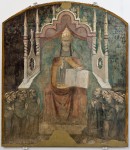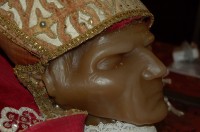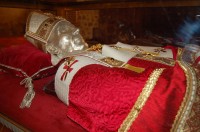 Celestine V’s papacy was doomed from the start. Born Pietro Angelerio in Sicily, from his early 20s until old age he was an ascetic hermit who lived in a succession of remote caves on top of mountains and modeled his life after John the Baptist. He founded the Celestine monastic order whose rule was based on his own strict practices of hair shirts and bread-and-water fasts, but left it to somebody else to run so he could retire to his beloved mountain-top cave. He was only dislodged from there very much against his will when the cardinals declared him Pope in 1294.
Celestine V’s papacy was doomed from the start. Born Pietro Angelerio in Sicily, from his early 20s until old age he was an ascetic hermit who lived in a succession of remote caves on top of mountains and modeled his life after John the Baptist. He founded the Celestine monastic order whose rule was based on his own strict practices of hair shirts and bread-and-water fasts, but left it to somebody else to run so he could retire to his beloved mountain-top cave. He was only dislodged from there very much against his will when the cardinals declared him Pope in 1294.
That was the last thing he wanted. The problem was the cardinals had been trying for two years to decide who should be pope after the death of Nicholas IV in 1292, but divisions between Guelph and Ghibelline factions and rivalries between the great Roman families of the Orsini and the Colonna (out of the 11 cardinals, three were Orsini, two Colonna and one, Benedetto Gaetani, Colonna-affiliated) had caused a seemingly unbreakable stalemate. At that time there was no conclave locking them in the Vatican until the decision was made, so two years of dithering were entirely comfortable. Pietro sent them a stern letter telling them God had told him that if they didn’t elect a Pope in four months, His wrathful vengeance would fall upon them. Much to his horror, their response was to elect him Pope.
At first he categorically refused and even tried to run away, but he was 79 years old and 200,000 people had flocked to his mountain after the news broke. Finally a delegation of cardinals and two kings (the Angevin King Charles II of Naples and his son, King Charles I Martel of Hungary) convinced him to don the mitre. On August 29th, 1294, almost two months after his election, Pietro was crowned Pope in L’Aquila and became Celestine V.
He was awful at it. Charles II hadn’t climbed that mountain just to pay his respects; he was looking to secure himself a pet Pope and secure him he did. Celestine never entered the Papal States, never went to Rome. He moved from L’Aquila, then a territory of the Kingdom of Naples, to Naples proper. He lived in a spare room in the Castel Nuovo — he had a tiny cell built so he could be properly eremitical during Advent — and appointed everyone who wanted anything to whatever they wanted, even if he’d already appointed someone else. For Charles he created 12 new cardinals, seven of them French and three or five of them Neapolitans. That completely altered the makeup of the college, giving the French massive new weight which would directly lead to the disaster of the Western Schism and the Avignon papacy 80 years later.
After a mere five months on the job, Celestine couldn’t take it anymore. He asked canon law expert Cardinal Benedetto Gaetani whether a pope could abdicate and Gaetani replied that he could, so long as he promulgated a decree saying that he could. On December 13th, 1294, Celestine V decreed that he was out of there. Eleven days later, the college of cardinals assembled in Naples and elected Benedetto Gaetani the new pope. He took the name Boniface VIII and hightailed it to Rome and out from under Charles II’s control.
 Celestine headed back to his mountain top but he didn’t make it. The abdication was contentious, and there were factions within the Church and in the temporal world who Boniface feared might attempt to install Pietro as an anti-pope. While still in Naples, Boniface ordered Celestine to be taken to Rome. The old man, remarkably spry considering his age, hair shirt, the chain he wrapped around his body and his only eating on Sundays, managed to escape. He was captured and escaped again. He tried to leave the country but a storm forced his ship ashore in Vieste, in Apuglia, the spur of Italy’s boot. There he was captured yet again and this time Boniface dispatched him to the Castle of Fumone in the Campania region.
Celestine headed back to his mountain top but he didn’t make it. The abdication was contentious, and there were factions within the Church and in the temporal world who Boniface feared might attempt to install Pietro as an anti-pope. While still in Naples, Boniface ordered Celestine to be taken to Rome. The old man, remarkably spry considering his age, hair shirt, the chain he wrapped around his body and his only eating on Sundays, managed to escape. He was captured and escaped again. He tried to leave the country but a storm forced his ship ashore in Vieste, in Apuglia, the spur of Italy’s boot. There he was captured yet again and this time Boniface dispatched him to the Castle of Fumone in the Campania region.
By all accounts, this imprisonment was not a gentle one. Even for a man with his taste for the Spartan, Celestine’s cell was tiny, so narrow that the two younger monks who accompanied him got sick. He died 10 months later, on May 19th, 1296. The circumstances of his death were immediately seen as suspicious. Boniface was accused of having had the old man killed to remove the potential anti-pope with undeniable finality. His enemies got their revenge in the end by having Celestine canonized a saint in 1313.
Pietro’s body was moved repeatedly after death, finally finding a permanent resting place in the Basilica of Santa Maria di Collemaggio in L’Aquila, although it didn’t get to rest easily. The silver coffin he was laid in was stolen in 1529; a new one was stolen in 1799; his remains were stolen in 1988 but found two days later, and in 2009, the glass casket that held his remains in public view was buried under the rubble of the church during the earthquake that devastated L’Aquila.
 For hundreds of years, a square hole in Pietro’s skull was considered evidence that he had been murdered by a nail driven through his head. Now pathologists at the San Salvatore Hospital’s in L’Aquila can confirm that the nail hole was definitely not the cause of death. Dr. Luca Ventura, son of the pathologist who last examined Celestine’s remains after the 1988 theft, studied the bones.
For hundreds of years, a square hole in Pietro’s skull was considered evidence that he had been murdered by a nail driven through his head. Now pathologists at the San Salvatore Hospital’s in L’Aquila can confirm that the nail hole was definitely not the cause of death. Dr. Luca Ventura, son of the pathologist who last examined Celestine’s remains after the 1988 theft, studied the bones.
“[O]ur analysis found no trace of the murder engineered by Boniface. On the contrary, we can say beyond doubt that Celestine wasn’t alive when the lesion was made.”
According to the researcher, the morphology of the lesion clearly shows it was produced on a skeletonized skull. Most likely, the hole was made with a pointed, metallic object during one of the many reburials of Celestine’s bones. […]
“We can’t establish the real cause of death,” Ventura said. “A previous research carried test for heavy metal poisoning with negative results.” […] “Contemporary sources cite pneumonia and a possible hemiplegia (paralysis of one side of the body),” Ventura said.
That doesn’t let Boniface off the hook. Even if he didn’t put a hit out on him — and we still don’t know if Celestine was killed by some other means — Boniface is responsible for walling up an sickly old man in a tortuously cramped castle cell. Osteological evidence indicates Celestine was 5’5″ tall, had chronic sinusitis, parodontopathy (a chronic bacterial infection of the gums), vertebral arthritis and Schmorl’s nodes, herniations of vertebral discs probably caused by heavy labor done as a youth. It’s impressive he lasted 10 months, all things considered.
 Researchers at L’Aquila University took the opportunity to do a laser scan on the skull so they could make an accurate facial reconstruction. There’s a practical reason for this reconstruction beyond just curiosity. When on display, Celestine’s remains are clothed and his skull face covered by a wax mask. The mask wasn’t a likeness of the saint, however, but rather that of Cardinal Carlo Confalonieri, the Archbishop of L’Aquila from 1941 to 1950. With the new facial reconstruction, artists were able to make a handsome silver funerary mask that is an accurate likeness of the face it now covers.
Researchers at L’Aquila University took the opportunity to do a laser scan on the skull so they could make an accurate facial reconstruction. There’s a practical reason for this reconstruction beyond just curiosity. When on display, Celestine’s remains are clothed and his skull face covered by a wax mask. The mask wasn’t a likeness of the saint, however, but rather that of Cardinal Carlo Confalonieri, the Archbishop of L’Aquila from 1941 to 1950. With the new facial reconstruction, artists were able to make a handsome silver funerary mask that is an accurate likeness of the face it now covers.

